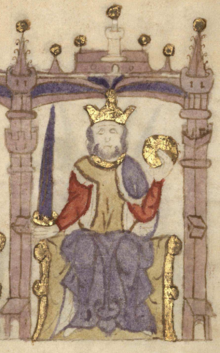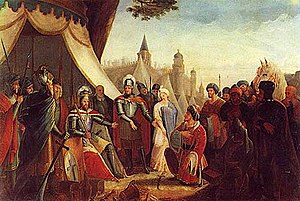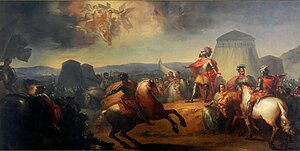Afonso I of Portugal
| Afonso I | |
|---|---|
 | |
| King of Portugal | |
| Reign | 26 July 1139 – 6 December 1185 |
| Acclamation | 26 July 1139 |
| Successor | Sancho I |
| Count of Portugal | |
| Reign | 12 May 1112 – 25 July 1139 |
| Predecessor | Henry |
| Regent | Theresa, Countess of Portugal (1112–1126) |
| Born | 25 July 1109 Coimbra, Guimarães or Viseu, County of Portugal[a] |
| Died | 6 December 1185 (aged 76) Coimbra, Kingdom of Portugal |
| Burial | |
| Consort | Mafalda of Savoy |
| Issue among others ... | Urraca, Queen of León Sancho I Theresa, Countess of Flanders |
| House | Burgundy |
| Father | Henry, Count of Portugal |
| Mother | Teresa of León, Countess of Portugal |
| Religion | Roman Catholic |
Afonso I[1] (25 July 1109, Coimbra, Guimarães or Viseu[a] – 6 December 1185, Coimbra), more commonly known as D. Afonso Henriques (Portuguese pronunciation: [ɐˈfõsu ẽˈʁikɨʃ]), nicknamed "the Conqueror" (Template:Lang-pt), "the Founder" ([O Fundador] Error: {{Lang}}: text has italic markup (help)) or "the Great" ([O Grande] Error: {{Lang}}: text has italic markup (help)) by the Portuguese, and El-Bortukali [in Arabic البرتغال] ("the Portuguese") and Ibn-Arrik [in Arabic ابن الرَّنك or ابن الرَنْق] ("son of Henry", "Henriques") by the Moors whom he fought, was the first King of Portugal. He achieved the independence of the southern part of the Kingdom of Galicia, the County of Portugal, from Galicia's overlord, the King of León, in 1139, establishing a new kingdom and doubling its area with the Reconquista, an objective that he pursued until his death, in 1185, after forty-six years of wars against the Moors.
Mother's rule
Afonso I was the son of Henry of Burgundy and Theresa, the natural daughter of King Alfonso VI of León and Castile. The pair reigned jointly as Count and Countess of Portugal until Henry's death, after which Theresa reigned alone.[2] Afonso was about three years old when his father Count Henry, died on 12 May 1112 during the siege of Astorga.[3] In an effort to pursue a larger share in the Leonese inheritance, his mother Theresa married Fernando Pérez, Count of Trava, the most powerful count in Galicia.[2]
The Portuguese nobility disliked the alliance between Galicia and Portugal and rallied around the infant Afonso. The Archbishop of Braga was also concerned with the dominance of Galicia, apprehensive of the ecclesiastical pretensions of his new rival the Galician Archbishop of Santiago de Compostela, Diego Gelmírez, who had claimed an alleged discovery of relics of Saint James in his town, as a way to gain power and riches over the other cathedrals in the Iberian Peninsula. In 1122, Afonso turned fourteen, the adult age in the 12th century. He made himself a knight on his own account in the Cathedral of Zamora, raised an army, and proceeded to take control of his mother's lands.
Sole count
In 1128, near Guimarães, at the Battle of São Mamede Afonso and his supporters overcame troops under his stepfather Count Fernando Peres de Trava of Galicia. Afonso exiled his mother to Galicia, and took over rule of the County of Portugal.[2] Thus the possibility of re-incorporating Portugal (up to then known as Southern Galicia) into a Kingdom of Portugal and Galicia as before was eliminated and Afonso became sole ruler following demands for independence from the county's church and nobles. He also vanquished his mother's nephew, Alfonso VII of León, who came to her rescue, and thus freed the country from political dependence on the crown of his cousin of León. On 6 April 1129, Afonso Henriques dictated the writ in which he proclaimed himself Prince of Portugal.
Afonso then turned his arms against the persistent problem of the Moors in the south. His campaigns were successful and, on 25 July 1139, he obtained an overwhelming victory in the Battle of Ourique, and straight after was unanimously proclaimed King of the Portuguese by his soldiers, establishing his equality in rank to the other realms of the Peninsula. The first assembly of the estates-general convened at Lamego (wherein he would have been given the crown from the Archbishop of Braga, to confirm his independence) is a 17th-century embellishment of Portuguese history.
Kingship
Independence from Alfonso VII of León's suzerainty, however, was not a thing he just could achieve militarily. The County of Portugal still had to be acknowledged diplomatically by the neighboring lands as a kingdom and, most importantly, by the Roman Catholic Church and the Pope. Afonso wed Mafalda of Savoy, daughter of Amadeus III, Count of Savoy, and sent ambassadors to Rome to negotiate with the Pope. He succeeded in renouncing the suzerainty of his cousin, Alfonso VII of León, becoming instead a vassal of the papacy, as the kings of Sicily and Aragon had done before him. In 1179 the bull Manifestis Probatum accepted the new king as vassal to the pope exclusively.

In Portugal he built several monasteries and convents and bestowed important privileges to religious orders. He is notably the builder of Alcobaça Monastery, to which he called the Cistercian Order of his uncle Bernard of Clairvaux of Burgundy. In 1143, he wrote to Pope Innocent II to declare himself and the kingdom servants of the church, swearing to pursue driving the Moors out of the Iberian Peninsula. Bypassing any king of León, Afonso declared himself the direct liege man of the papacy. Afonso continued to distinguish himself by his exploits against the Moors, from whom he wrested Santarém (see Conquest of Santarém) and Lisbon in 1147 (see Siege of Lisbon). He also conquered an important part of the land south of the Tagus River, although this was lost again to the Moors in the following years.
Meanwhile, King Alfonso VII of León (Afonso's cousin) regarded the independent ruler of Portugal as nothing but a rebel. Conflict between the two was constant and bitter in the following years. Afonso became involved in a war, taking the side of the Aragonese king, an enemy of Castile. To ensure the alliance, his son Sancho was engaged to Dulce, sister of the Count of Barcelona and Infanta of Aragon. Finally after winning the Battle of Valdevez, the Treaty of Zamora (1143) established peace between the cousins and the recognition by the Kingdom of León that Portugal was a sovereign kingdom.
In 1169 the now old Dom Afonso was disabled in an engagement near Badajoz by a fall from his horse, and made prisoner by the soldiers of the king of León Ferdinand II also his son-in-law. Portugal was obliged to surrender as his ransom almost all the conquests Afonso had made in Galicia (north of the Minho River) in the previous years.

In 1179 the privileges and favours given to the Roman Catholic Church were compensated. In the papal bull Manifestis Probatum, Pope Alexander III acknowledged Afonso as king and Portugal as an independent crown with the right to conquer lands from the Moors. With this papal blessing, Portugal was at last secured as a kingdom.
In 1184, in spite of his great age, he still had sufficient energy to relieve his son Sancho, who was besieged in Santarém by the Moors. Afonso died shortly after, on 6 December 1185. The Portuguese revere him as a hero, both on account of his personal character and as the founder of their nation. There are mythical stories that it took 10 men to carry his sword, and that Afonso wanted to engage other monarchs in personal combat, but no one would dare accept his challenge.
Scientific research

In July 2006, the tomb of the king (which is located in the Santa Cruz Monastery in Coimbra) was to be opened for scientific purposes by researchers from the University of Coimbra (Portugal) and the University of Granada (Spain). The opening of the tomb provoked considerable concern among some sectors of Portuguese society and IPPAR – Instituto Português do Património Arquitectónico (Portuguese State Agency for Architectural Patrimony). The government halted the opening, requesting more protocols from the scientific team because of the importance of the king in the nation's formation.[4][5]
Ancestors
These are the known ancestors of Afonso Henriques, going back five generations.
| Family of Afonso I of Portugal | ||||||||||||||||||||||||||||||||||||||||||||||||||||||||||||||||||||||||||||||||||||||||||||||||||||||||||||||||||||||||||||||||||||||||||||||||||||||||||||||||||||||||||||||||||||||||||||||||||||||||||||||||||||||||||||||||||||||||||||||||||||||||||||||||||||||||||||||||||||||||||||||||||||||||||||||||||||||||||||||||||||||||||||||||||||||||||||||||||||||||||||||||||||||||||||||||||||||||||||||||||||||||||||||||||||||||||||||||||||||||||||||||||||||||||||||||||||||||||||||||||||||||||||||||||||||||||||||||||||||||||||||||||||||||||||||||||||||||||||||||||||||||||||||||
|---|---|---|---|---|---|---|---|---|---|---|---|---|---|---|---|---|---|---|---|---|---|---|---|---|---|---|---|---|---|---|---|---|---|---|---|---|---|---|---|---|---|---|---|---|---|---|---|---|---|---|---|---|---|---|---|---|---|---|---|---|---|---|---|---|---|---|---|---|---|---|---|---|---|---|---|---|---|---|---|---|---|---|---|---|---|---|---|---|---|---|---|---|---|---|---|---|---|---|---|---|---|---|---|---|---|---|---|---|---|---|---|---|---|---|---|---|---|---|---|---|---|---|---|---|---|---|---|---|---|---|---|---|---|---|---|---|---|---|---|---|---|---|---|---|---|---|---|---|---|---|---|---|---|---|---|---|---|---|---|---|---|---|---|---|---|---|---|---|---|---|---|---|---|---|---|---|---|---|---|---|---|---|---|---|---|---|---|---|---|---|---|---|---|---|---|---|---|---|---|---|---|---|---|---|---|---|---|---|---|---|---|---|---|---|---|---|---|---|---|---|---|---|---|---|---|---|---|---|---|---|---|---|---|---|---|---|---|---|---|---|---|---|---|---|---|---|---|---|---|---|---|---|---|---|---|---|---|---|---|---|---|---|---|---|---|---|---|---|---|---|---|---|---|---|---|---|---|---|---|---|---|---|---|---|---|---|---|---|---|---|---|---|---|---|---|---|---|---|---|---|---|---|---|---|---|---|---|---|---|---|---|---|---|---|---|---|---|---|---|---|---|---|---|---|---|---|---|---|---|---|---|---|---|---|---|---|---|---|---|---|---|---|---|---|---|---|---|---|---|---|---|---|---|---|---|---|---|---|---|---|---|---|---|---|---|---|---|---|---|---|---|---|---|---|---|---|---|---|---|---|---|---|---|---|---|---|---|---|---|---|---|---|---|---|---|---|---|---|---|---|---|---|---|---|---|---|---|---|---|---|---|---|---|---|---|---|---|---|---|---|---|---|---|---|---|---|---|---|---|---|---|---|---|---|---|---|---|---|---|---|---|---|---|---|---|---|---|---|---|---|---|---|---|---|---|---|---|---|---|---|---|---|---|---|---|---|---|---|---|---|---|---|---|---|---|---|---|---|---|---|---|---|---|---|---|---|---|---|---|---|---|---|---|---|---|---|---|---|---|---|---|---|---|---|---|---|---|---|---|---|---|---|---|---|---|---|---|---|---|---|---|---|---|---|---|---|---|---|---|---|---|---|---|---|---|---|---|---|---|---|---|---|---|---|---|---|---|---|---|---|---|---|---|---|---|---|---|---|---|---|---|---|---|---|---|---|---|---|---|---|---|---|---|---|---|---|
| ||||||||||||||||||||||||||||||||||||||||||||||||||||||||||||||||||||||||||||||||||||||||||||||||||||||||||||||||||||||||||||||||||||||||||||||||||||||||||||||||||||||||||||||||||||||||||||||||||||||||||||||||||||||||||||||||||||||||||||||||||||||||||||||||||||||||||||||||||||||||||||||||||||||||||||||||||||||||||||||||||||||||||||||||||||||||||||||||||||||||||||||||||||||||||||||||||||||||||||||||||||||||||||||||||||||||||||||||||||||||||||||||||||||||||||||||||||||||||||||||||||||||||||||||||||||||||||||||||||||||||||||||||||||||||||||||||||||||||||||||||||||||||||||||
Descendants
Afonso married in 1146 Mafalda of Savoy (1125–1158), daughter of Amadeo III, Count of Savoy, and Mahaut of Albon.[6]
| Name | Birth | Death | Notes |
|---|---|---|---|
| By Mafalda of Savoy (1125–1158; married in 1146) | |||
| Henry (Henrique) | 5 March 1147 | 1147 | |
| Mafalda | 1148 | c. 1160 | |
| Urraca | c. 1151 | 1188 | Married Ferdinand II of León. |
| Sancha | 1153 | 1159 | |
| Sancho | 1154 | 26 March 1212 | Succeeded him as Sancho I, 2nd King of Portugal |
| John (João) | 1156 | 1156 | |
| Theresa (Teresa) | 1157 | 1218 | Married successively Philip I of Flanders and Odo III, Duke of Burgundy. |
| Extramarital offspring by Elvira Gálter | |||
| Urraca Afonso | c. 1130 | ? | Married Pedro Afonso Viegas. Lady of Aveiro. |
| Other extramarital offspring | |||
| Fernando Afonso | ?[7] | c. 1172 | High-General of the Kingdom (Constable of Portugal) |
| Pedro Afonso | c 1130 | 1169 | A.k.a. Pedro Henriques. 1st Grand-Master of the Order of Aviz. |
| Afonso | c. 1135 | 1207 | 12th Grand Master of the Order of Saint John of Rhodes (also known as the Knights Hospitaller). |
| Teresa Afonso | c. 1135 | ? | Married Fernando Martins Bravo or Martim Moniz. |
See also
- Portugal
- Gallaecia
- Galicia
- History of Portugal
- Timeline of Portuguese history
- Estádio D. Afonso Henriques
Notes
^ a: The actual birthplace is unknown, but Portuguese popular tradition indicates Guimarães as the birth place. Portuguese historian Almeida Fernandes was the first to defend Viseu as the king's birth place, historian Mattoso considers the Viseu's hypothesis as likely[8]
References
- ^ Or also Affonso (Archaic Portuguese-Galician) or Alphonso (Portuguese-Galician) or Alphonsus (Latin version), sometimes rendered in English as Alphonzo or Alphonse, depending on the Spanish or French influence.
- ^ a b c Gerli, E. Michael. Medieval Iberia, Routledge, 2013, ISBN 9781136771613
- ^ Mattoso, José (2014). D. Afonso Henriques (in Portuguese) (2nd ed.). Lisbon: Temas e Debates. ISBN 978-972-759-911-0
- ^ IPPAR: direcção nacional diz que não foi consultada sobre abertura do túmulo de D. Afonso Henriques, Público, 6 July 2006. Retrieved December 2006 (in Portuguese)
- ^ n:Portuguese Culture Ministry suspends opening of Afonso I's tomb
- ^ Previte-Orton 1912, p. 313.
- ^ c. (1166 is an erroneous date)
- ^ Mattos p.27
Bibliography
- Baquero Moreno, Humberto (2006). "Portugal e o reino das Astúrias no período de formação". Astúrias e Portugal. Relações históricas e culturais. Actas do Colóquio 5 a 7 de Dezembro de 2005 (in Portuguese). Lisbon: Academia Portuguesa da História. pp. 115–141. ISBN 972-624-164-2.
{{cite book}}: Invalid|ref=harv(help) - Caetano de Souza, Antonio (1735). Historia Genealógica de la Real Casa Portuguesa (PDF) (in Portuguese). Vol. Vol. I. Lisbon: Lisboa Occidental, na oficina de Joseph Antonio da Sylva. ISBN 978-84-8109-908-9.
{{cite book}}:|volume=has extra text (help); Cite has empty unknown parameter:|1=(help); Invalid|ref=harv(help) - Calderón Medina, Inés (2004). "La nobleza portuguesa al servicio del rey de León 1157-1187. Pero Pais de Maia y Vasco Fernandes de Soverosa". Actas IV Simposio Internacional de Jóvenes Medievalistas, Lorca 2008 (PDF) (in Spanish). Universidad de Murcia, Sociedad Española de Estudios Medievales, Ayuntamiento de Lorca, et al. pp. 39–50. ISBN 978-84-8371-801-8.
{{cite book}}: Invalid|ref=harv(help) - Freitas do Amaral, Diogo (2000). D. Afonso Henriques (in Portuguese). Lisbon: Bertrand. ISBN 972-25-1157-2.
{{cite book}}: Invalid|ref=harv(help) - Mattoso, José (2014). D. Afonso Henriques (in Portuguese). Lisbon: Temas e Debates. ISBN 978-972-759-911-0.
{{cite book}}: Invalid|ref=harv(help) - Previte-Orton, C.W. (1912). The Early History of the House of Savoy: 1000-1233. Cambridge University Press.
{{cite book}}: Invalid|ref=harv(help) - Rodrigues Oliveira, Ana (2010). Rainhas medievais de Portugal. Dezassete mulheres, duas dinastias, quatro séculos de História (in Portuguese). Lisbon: A esfera dos livros. ISBN 978-989-626-261-7.
{{cite book}}: Invalid|ref=harv(help) - Sánchez Candeira, Alfonso (1999). Rosa Montero Tejada (edition sponsored by Fundación BBV, Fundación Ramón Areces, Caja Madrid Fundación) (ed.). Castilla y León en el siglo XI, estudio del reinado de Fernando I. Madrid: Real Academia de la Historia. ISBN 978-84-8951241-2.
{{cite book}}: Invalid|ref=harv(help)CS1 maint: multiple names: editors list (link) - Sotto Mayor Pizarro, José Augusto (1997). Linhagens Medievais Portuguesas: Genealogias e Estratégias (1279-1325 (in Portuguese). Vol. Vol. I. Oporto: Doctorate thesis, author’s edition.
{{cite book}}:|volume=has extra text (help); Invalid|ref=harv(help) - Torres Sevilla-Quiñones de León, Margarita Cecilia (1999). Linajes nobiliarios de León y Castilla: Siglos IX-XIII (in Spanish). Salamanca: Junta de Castilla y León, Consejería de educación y cultura. ISBN 84-7846-781-5.
{{cite book}}: Cite has empty unknown parameters:|1=and|2=(help); Invalid|ref=harv(help) - This article incorporates text from a publication now in the public domain: Chisholm, Hugh, ed. (1911). "Alphonso". Encyclopædia Britannica (11th ed.). Cambridge University Press.
External links
- Use dmy dates from July 2012
- Portuguese Roman Catholics
- Roman Catholic monarchs
- Portuguese monarchs
- House of Burgundy-Portugal
- People of the Reconquista
- 1109 births
- 1185 deaths
- 12th-century Roman Catholics
- Christians of the Second Crusade
- Counts of Portugal (Asturias-León)
- County of Portugal
- 12th-century Portuguese monarchs
- Portuguese revolutionaries


